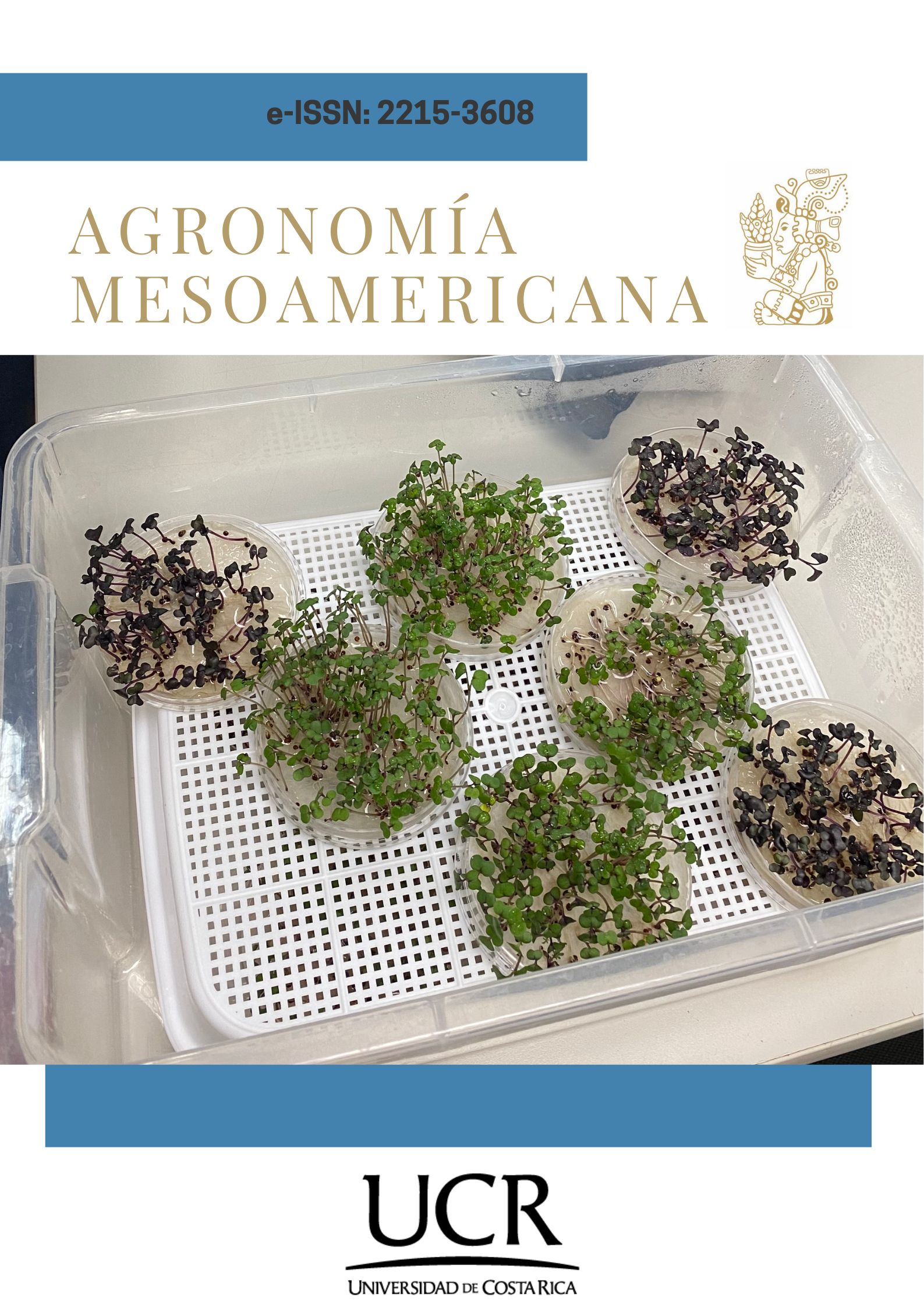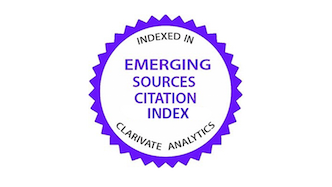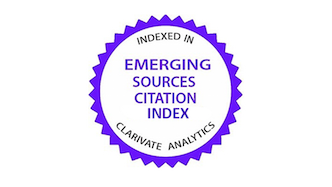Effect of Bacillus spp. as a biostimulant for Brassica oleracea var. capitata and Brassica oleracea var. sabellica microgreens
DOI:
https://doi.org/10.15517/am.2025.61996Keywords:
biostimulants, brassicas, microgreens, yieldAbstract
Introduction. The Bacillus genus has been used as a biostimulant with positive effects on crop yield and quality. However, there are few studies on its application in microgreens. Objective. To evaluate the effect of Bacillus subtilis (BsC4 and BsPC) and Bacillus thuringiensis (Bt24) as biostimulants on the germination and growth of red cabbage (Brassica oleracea var. capitata) and kale (Brassica oleracea var. sabellica) microgreens under controlled environmental conditions. Materials and methods. The study was conducted at the Universidad Autónoma de Chihuahua, Mexico, in 2023. Four treatments were assessed: Bt24, BsC4, BsPC, and seedlings without microorganisms (control) on red cabbage and kale seeds, under a completely randomized design (n = 5). Germination was monitored in the first trial, and microgreens development was assessed in the second. After 15 days, morphological variables, photosynthetic pigments, nitrate content, quality, and yield were measured. Data were analyzed using analysis of variance and Tukey’s tests (p < 0.05). Results. For kale, Bt24 improved germination speed (31.17 %) and reduced germination time (4.61 %), with no significant effect on red cabbage. In kale, yield increased (62.60 %) with Bt24, particularly in fresh biomass (63.3 %) and cotyledon area (61.57 %). In cabbage, BsC4 increased yield (44.31 %) and improved fresh biomass (42.21 %) and cotyledon area (50.57 %). Nitrate content was highest in kale with BsPC (138.30 %) and in red cabbage with Bt24 (65.14 %), while remaining within safe consumption limits. For visual quality, both crops achieved the “Good” and “Excellent” categories, with no differences between treatments. Conclusions. B. thuringiensis and B. subtilis could be used as growth biostimulants for cabbage and kale microgreens, offering a promising approach to optimize microgreen production under controlled environmental conditions.
Downloads
References
Akhtar, N., Ilyas, N., Yasmin, H., Sayyed, R. Z., Hasnain, Z., Elsayed, A., & El Enshasy, H. A. (2021). Role of Bacillus cereus in improving the growth and phytoextractability of Brassica nigra (L.) K. Koch in chromium contaminated soil. Molecules, 26(6), Article 1569. https://doi.org/10.3390/molecules26061569
Alloggia, F. P., Bafumo, R. F., Ramirez, D. A., Maza, M. A., & Camargo, A. B. (2023). Brassicaceae microgreens: a novel and promissory source of sustainable bioactive compounds. Current Research in Food Science, 6, Article 100480. https://doi.org/10.1016/j.crfs.2023.100480
Al-Ansari, F., & Ksiksi, T. (2016). A quantitative assessment of gemination parameters: the case of Crotolaria persica and Tephrosia apollinea. The Open Ecology Journal, 9(1), 13–21.
Arif, S., Liaquat, F., Yang, S., Shah, I. H., Zhao, L., Xiong, X., Garcia, D., & Zhang, Y. (2021). Exogenous inoculation of endophytic bacterium Bacillus cereus suppresses clubroot (Plasmodiophora brassicae) occurrence in pak choi (Brassica campestris sp. chinensis L.). Plants, 253, Article 25. https://doi.org/10.1007/s00425-020-03546-4
Arkhipova, T. N., Veselov, S. U., Melentiev, A. I., Martynenko, E. V., & Kudoyarova, G. R. (2005). Ability of bacterium Bacillus subtilis to produce cytokinins and to influence the growth and endogenous hormone content of lettuce plants. Plant and Soil, 272, 201–209. https://doi.org/10.1007/s11104-004-5047-x
Aziz, Z. F. A., Saud, H. M., Rahim, K. A., & Ahmed, O. H. (2012). Variable responses on early development of shallot (Allium ascalonicum) and mustard (Brassica juncea) plants to Bacillus cereus inoculation. Malaysian Journal of Microbiology, 8(1), 47–50. http://dx.doi.org/10.21161/mjm.33711
Benincasa, P., Falcinelli, B., Lutts, S., Stagnari, F., & Galieni, A. (2019). Sprouted grains: A comprehensive review. Nutrients, 11(2), Article 421. https://doi.org/10.3390/nu11020421
Berlanga-Clavero, M. V., Molina-Santiago, C., Caraballo-Rodríguez, A. M., Petras, D., Díaz-Martínez, L., Pérez-García, A., De Vicente, A., Dorrestein, P. C., & Romero, D. (2021). Mutualistic interactions between B. subtilis and seeds dictate plant development. bioRxiv, Article 447311. https://doi.org/10.1101/2021.06.07.447311
Blake, C., Christensen, M. N., & Kovács, A. T. (2021). Molecular aspects of plant growth promotion and protection by Bacillus subtilis. Molecular Plant Microbe Interaction, 34(1), 15–25. https://doi.org/10.1094/MPMI-08-20-0225-CR
Caracciolo, F., El-Nakhel, C., Raimondo, M., Kyriacou, M. C., Cembalo, L., De Pascale, S., & Rouphael, Y. (2020). Sensory attributes and consumer acceptability of 12 microgreens species. Agronomy, 10(7), Article 1043. https://doi.org/10.3390/agronomy10071043
Cataldo, D. A., Maroon, M., Schrader, L. E., & Youngs, V. L. (1975). Rapid colorimetric determination of nitrate in plant tissue by nitration of salicylic acid. Communications in Soil Science and Plant Analysis, 6(1), 71–80. https://doi.org/10.1080/00103627509366547
Chandrasekaran, M., Belachew, S. T., Yoon, E., & Chun, S. C. (2017). Expression of β-1,3-glucanase (GLU) and phenylalanine ammonia-lyase (PAL) genes and their enzymes in tomato plants induced after treatment with Bacillus subtilis CBR05 against Xanthomonas campestris pv. vesicatoria. Journal of General Plant Pathology, 83, 7–13. https://doi.org/10.1007/s10327-016-0692-5
Da Silva Oliveira, C. E., Jalal, A., Vieira Aguilar, J., Santos de Camargos, L., Zoz, T., Ghaley, B. B., Abdel-Maksoud, M. A., Mohammed Alarjani, K., AbdElgawad, H., & Teixeira Filho, M. C. M. (2023). Yield, nutrition, and leaf gas exchange of lettuce plants in a hydroponic system in response to Bacillus subtilis inoculation. Frontiers in Plant Science, 14, Article 1248044. https://doi.org/10.3389/fpls.2023.1248044
Di Gioia, F., Renna, M., & Santamaria, P. (2017) Sprouts, microgreens and “Baby leaf” vegetables. In F. Yildiz, & R. C. Wiley (Eds.), Minimally processed refrigerated fruits and vegetables (pp. 403–432). Springer. https://doi.org/10.1007/978-1-4939-7018-6_11
Ebert, A. W. (2022). Sprouts and microgreens—Novel food sources for healthy diets. Plants, 11(4), Article 571. https://doi.org/10.3390/plants11040571
Eissa, N. H., Zayed, M. S., Hassanein, M. K., & Abdallah, M. M. F. (2018). Green pea sprout response to microbial inoculation and increasing atmospheric CO2 concentration. Arab Universities Journal Agriculture Sciences, 26(2D), 2513–2523. https://doi.org/10.21608/ajs.2018.35619
Etesami, H., & Glick, B. R. (2024). Bacterial indole-3-acetic acid: a key regulator for plant growth, plant-microbe interactions, and agricultural adaptive resilience. Microbiological Research, 281, Article 127602. https://doi.org/10.1016/j.micres.2024.127602
Fusari, C. M., Nazareno, M. A., Locatelli, D. A., Fontana, A., Beretta, V., & Camargo, A. B. (2020). Phytochemical profile and functionality of Brassicaceae species. Food Bioscience, 36, Article 100606. https://doi.org/10.1016/j.fbio.2020.100606
Galieni, A., Falcinelli, B., Stagnari, F., Datti, A., & Benincasa, P. (2020). Sprouts and microgreens: trends, opportunities, and horizons for novel research. Agronomy, 10(9), Article 1424. https://doi.org/10.3390/agronomy10091424
García, M., López, J. J., & Hidalgo, M. D. (1996). Análisis de datos categóricos. En J. Arnua (Coord.), Métodos y técnicas avanzadas de análisis de datos en ciencias del comportamiento (pp. 79–128). Unitat de Barcelona.
Ghosh, S., Bhattacharya, J., Nitnavare, R., & Webster, T. J. (2022). Heavy metal removal by Bacillus for sustainable agriculture. In M. T. Islam, M. Rahman, & P. Pandey. (Eds.), Bacilli in agrobiotechnology: Plant stress tolerance, bioremediation, and bioprospecting (pp. 1–30). Springer International Publishing. https://doi.org/10.1007/978-3-030-85465-2_1#DOI
González, H., & Fuentes, N. (2017). Mecanismo de acción de cinco microorganismos promotores de crecimiento vegetal. Revista de Ciencias Agrícolas, 34(1), 17–31. https://doi.org/10.22267/rcia.173401.60
Hernández-Valladares, N. L., Palemón-Alberto, F., Damián-Nava, A., Cruz-Lagunas, B., Herrera-Castro, N. D., Ortega-Acosta, S. Á., Toribio-Jiménez, J., & Reyes-García, G. (2021). Inoculación de bacterias promotoras de crecimiento vegetal y su efecto en ecotipos de tomate. Revista Fitotecnia Mexicana, 44(4), 581–589. https://doi.org/10.35196/rfm.2021.4.581
Hu, Q.-P., Guo, J., & Liu, J.-J. (2022). Wheat seed germination based on α-amylase activity to study promoting mechanism of Bacillus subtilis QM3. Journal of Seed Science, 44, e202244039. https://doi.org/10.1590/2317-1545v44263126
Ilangumaran, G., & Smith, D. L. (2017). Plant growth promoting rhizobacteria in amelioration of salinity stress: a systems biology perspective. Frontiers in Plant Science, 8, Article 1768. https://doi.org/10.3389/fpls.2017.01768
Iqbal, M., Naveed, M., Sanaullah, M., Brtnicky, M., Hussain, M. I., Kucerik, J., Holatko, J., & Mustafa, A. (2023). Plant microbe mediated enhancement in growth and yield of canola (Brassica napus L.) plant through auxin production and increased nutrient acquisition. Journal of Soils and Sediments, 23(3), 1233–1249. https://doi.org/10.1007/s11368-022-03386-7
Kanjanamaneesathian, M., Wiwattanapatapee, R., Rotniam, W., & Wongpetkhiew, W. (2014). Spraying hydroponic lettuce roots with a suspension concentrate formulation of Bacillus velezensis to suppress root rot disease and promote plant growth. New Zealand Plant Protection, 67, 213–219. https://doi.org/10.30843/nzpp.2014.67.5734
Katsenios, N., Christopoulos, N. V., Kakabouki, I., Vlachakis, D., Kavvadias, V., & Efthimiadou, A. (2021). Effect of pulsed electromagnetic field on growth, physiology and postharvest quality of kale (Brassica oleracea), wheat (Triticum durum) and spinach (Spinacia oleracea) microgreens. Agronomy, 11(7), Article 1364. https://doi.org/10.3390/agronomy11071364
Kyriacou, M. C., Rouphael, Y., Di Gioia, F., Kyratzis, A., Serio, F., Renna, M., De Pascale, S., & Santamaria, P. (2016). Micro-scale vegetable production and the rise of microgreens. Trends in Food Science & Technology, 57(A), 103–115. https://doi.org/10.1016/j.tifs.2016.09.005
Lastochkina, O., Seifikalhor, M., Aliniaeifard, S., Baymiev, A., Pusenkova, L., Garipova, S., Kulabuhova, D., & Maksimov, I. (2019). Bacillus spp.: efficient biotic strategy to control postharvest diseases of fruits and vegetables. Plants, 8(4), Article 97. https://doi.org/10.3390/plants8040097
Lee, J. S., Pill, W. G., Cobb, B. B., & Olszewski, M. (2004). Seed treatments to advance greenhouse establishment of beet and chard microgreens. The Journal of Horticultural Science and Biotechnology, 79(4), 565–570. https://doi.org/10.1080/14620316.2004.11511806
Li, Y.-J., & Hu, Q.-P. (2020). Studying of the promotion mechanism of Bacillus subtilis QM3 on wheat seed germination based on β-amylase. Open Life Science, 15(1), 553–560. https://doi.org/10.1515/biol-2020-0062
Li, T., Lalk, G. T., & Bi, G. (2021). Fertilization and pre-sowing seed soaking affect yield and mineral nutrients of ten microgreen species. Horticulturae, 7(2), Article 14. https://doi.org/10.3390/horticulturae7020014
Lichtenthaler, H. K., & Wellburn, A. R. (1983). Determinations of total carotenoids and chlorophylls a and b of leaf extracts in different solvents. Biochemical Society Transactions, 11(5), 591–592. https://doi.org/10.1042/bst0110591
Luetic, S., Knezovic, Z., Jurcic, K., Majic, Z., Tripkovic, K., & Sutlovic, D. (2023). Leafy vegetable nitrite and nitrate content: potential health effects. Foods, 12(8), Article 1655. https://doi.org/10.3390/foods12081655
Mir, S. A., Shah, M. A., & Mir, M. M. (2017). Microgreens: production, shelf life, and bioactive components. Critical Reviews in Food Science and Nutrition, 57(12), 2730–2736. https://doi.org/10.1080/10408398.2016.1144557
Misra, S., & Chauhan, P. S. (2020). ACC deaminase-producing rhizosphere competent Bacillus spp. mitigate salt stress and promote Zea mays growth by modulating ethylene metabolism. 3 Biotech, 10(3), Article 119. https://doi.org/10.1007/s13205-020-2104-y
Naing, A. H., Maung, T. T., & Kim, C. K. (2021). The ACC deaminase-producing plant growth-promoting bacteria: influences of bacterial strains and ACC deaminase activities in plant tolerance to abiotic stress. Physiologia Plantarum, 173(4), 1992–2012. https://doi.org/10.1111/ppl.13545
Ndeddy Aka, R. J., & Babalola, O. O. (2016). Effect of bacterial inoculation of strains of Pseudomonas aeruginosa, Alcaligenes faecalis and Bacillus subtilis on germination, growth, and heavy metal (Cd, Cr, and Ni) uptake of Brassica juncea. International Journal of Phytoremediation, 18(2), 200–209. https://doi.org/10.1080/15226514.2015.1073671
Palmitessa, O. D., Renna, M., Crupi, P., Lovece, A., Corbo, F., & Santamaria, P. (2020). Yield and quality characteristics of Brassica microgreens as affected by the NH4: NO3 molar ratio and strength of the nutrient solution. Foods, 9(5), Article 677. https://doi.org/10.3390/foods9050677
Paradiso, V. M., Castellino, M., Renna, M., Gattullo, C. E., Calasso, M., Terzano, R., Allegretta, I., Leoni, B., Caponio, F., & Santamaria, P. (2018). Nutritional Characterization and shelf-life of packaged microgreens. Food & Function, 9(11), 5629–5640. https://doi.org/10.1039/C8FO01182F
Ramirez, D., Abellán-Victorio, A., Beretta, V., Camargo, A., & Moreno, D. A. (2020). Functional ingredients from Brassicaceae species: overview and perspectives. International Journal of Molecular Science, 29(6), Article 1998. https://doi.org/10.3390/ijms21061998
Ranal, M. A., & Garcia de Santana, D. (2006). How and why to measure the germination process? Brazilian Journal of Botany, 29(1), 1–11. https://doi.org/10.1590/S0100-84042006000100002
Rennie, T. J., Vigneault, C., Raghavan, G. S. V., & DeEll, J. R. (2001). Effect of pressure reduction rate on vacuum cooled lettuce quality during storage. Canadian Biosystems Engineering, 43(3), 39–43. https://www.library.csbe-scgab.ca/all-publications/2439:effects-of-pressure-reduction-rate-on-vacuum-cooled-lettuce-quality-during-storage
Ryu, C.-M., Farag, M. A., Hu, C.-H., Reddy, M. S., Wei, H.-X., Paré, P. W., & Kloepper, J. W. (2003). Bacterial volatiles promote growth in Arabidopsis. Proceedings of the National Academy of Sciences, 100(8), 4927–4932. https://doi.org/10.1073/pnas.0730845100
Saengha, W., Karirat, T., Buranrat, B., Matra, K., Deeseenthum, S., Katisart, T., & Luang-In, V. (2021). Cold plasma treatment on mustard green seeds and its effect on growth, isothiocyanates, antioxidant activity and anticancer activity of microgreens. International Journal of Agriculture and Biology, 25, 667–676.
Santoyo, G., Guzmán-Guzmán, P., Parra-Cota, F. I., De los Santos-Villalobos, S., Orozco-Mosqueda, M. del C., & Glick, B. R. (2021). Plant growth stimulation by microbial consortia. Agronomy, 11(2), Article 219. https://doi.org/10.3390/agronomy11020219
Tan, L., Nuffer, H., Feng, J., Kwan, S. H., Chen, H., Tong, X., & Kong, L. (2020). Antioxidant properties and sensory evaluation of microgreens from commercial and local farms. Food Science and Human Wellness, 9(1), 45–51. https://doi.org/10.1016/j.fshw.2019.12.002
The Jamovi Projet. (s. f.). Jamovi. Versión 2.5.2.0. https://www.jamovi.org
Trujillo Peralta, F. A., López Avilés, G., Mondragón Camarillo, L., & Calderón, K. (2023). Bacterias tolerantes y resistentes a los metales pesados en el ambiente. Epistemus (Sonora), 17(35), 80–87. https://epistemus.unison.mx/index.php/epistemus/article/view/287
Tsotetsi, T., Nephali, L., Malebe, M., & Tugizimana, F. (2022). Bacillus for plant growth promotion and stress resilience: what have we learned? Plants, 11(19), Article 2482. https://doi.org/10.3390/plants11192482
Turan, M., Ekinci, M., Yildirim, E., Günes, A., Karagöz, K., Kotan, R., & Dursun, A. (2014). Plant growth-promoting rhizobacteria improved growth, nutrient, and hormone content of cabbage (Brassica oleracea) seedlings. Turkish Journal of Agriculture and Forestry, 38(3), 327–333. https://doi.org/10.3906/tar-1308-62
Vela-Corcia, D., Hierrezuelo, J., Pérez-Lorente, A. I., Stincone, P., Pakkir Shah, A. K., Grélard, A., Zi-Long, Y., De Vicente, A., Pérez García, A., Bai, L., Loquet, A., Petras, D., & Romero, D. (2024). Cyclo(Pro-Tyr) elicits conserved cellular damage in fungi by targeting the [H+]ATPase Pma1 in plasma membrane domains. Communications Biology, 7(1), Article 1253. https://doi.org/10.1038/s42003-024-06947-3
Waguespack, E., Bush, E., & Fontenot, K. (2022). The effect of organic biostimulants on beneficial soil microorganism activity. Open Journal of Ecology, 12(8), 499–512. https://doi.org/10.4236/oje.2022.128027
Wan, M. W. M. A., Naing, N. N., & Abd, N. N. (2008). An application of box-cox transformation to biostatistics experiment data. Journal of Bioscience, 19(1), 137–145.
Wang, R., Li., B., Jin, T., Weng, Q., & Liu, P. (2024). Bacillus velezensis stimulated the absorption of iodine to improve antioxidants and delay post-harvest senescence in microgreens. LWT, 197, Article 115898. https://doi.org/10.1016/j.lwt.2024.115898
Wardle, D. A., Ahmed, M., & Nicholson, K. S. (1991). Allelopathic influence of nodding thistle (Carduus nutans L.) seeds on germination and radicle growth of pasture plants. New Zealand Journal of Agricultural Research, 34(2), 185–191. https://doi.org/10.1080/00288233.1991.10423358
Weinand, T., El-Hasan, A., & Asch, F. (2023). Role of Bacillus spp. plant growth promoting properties in mitigating biotic and abiotic stresses in lowland rice (Oryza sativa L.). Microorganisms, 11(9), Article 2327. https://doi.org/10.3390/microorganisms11092327
Xiao, Z., Rausch, S. R., Luo, Y., Sun, J., Yu, L., Wang, Q., Chen, P., Yu, L., & Stommel, J. R. (2019). Microgreens of Brassicaceae: genetic diversity of phytochemical concentrations and antioxidant capacity. LWT, 101, 731–737. https://doi.org/10.1016/j.lwt.2018.10.076
Zhang, H., Kim, M.-S., Krishnamachari, V., Payton, P., Sun, Y., Grimson, M., Farag, M. A., Ryu, C.-M., Allen, R., Melo, I. S., & Paré, P. W. (2007). Rhizobacterial volatile emissions regulate auxin homeostasis and cell expansion in Arabidopsis. Plants, 226, 839–851. https://doi.org/10.1007/s00425-007-0530-2

Additional Files
Published
License

This work is licensed under a Creative Commons Attribution-NonCommercial-NoDerivatives 4.0 International License.
1. Proposed policy for open access journals
Authors who publish in this journal accept the following conditions:
a. Authors retain the copyright and assign to the journal the right to the first publication, with the work registered under the attribution, non-commercial and no-derivative license from Creative Commons, which allows third parties to use what has been published as long as they mention the authorship of the work and upon first publication in this journal, the work may not be used for commercial purposes and the publications may not be used to remix, transform or create another work.
b. Authors may enter into additional independent contractual arrangements for the non-exclusive distribution of the version of the article published in this journal (e.g., including it in an institutional repository or publishing it in a book) provided that they clearly indicate that the work was first published in this journal.
c. Authors are permitted and encouraged to publish their work on the Internet (e.g. on institutional or personal pages) before and during the review and publication process, as it may lead to productive exchanges and faster and wider dissemination of published work (see The Effect of Open Access).






























